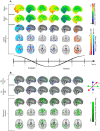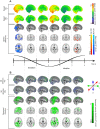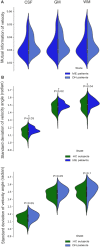Respiratory brain impulse propagation in focal epilepsy
- PMID: 36997658
- PMCID: PMC10063583
- DOI: 10.1038/s41598-023-32271-7
Respiratory brain impulse propagation in focal epilepsy
Erratum in
-
Author Correction: Respiratory brain impulse propagation in focal epilepsy.Sci Rep. 2023 May 9;13(1):7515. doi: 10.1038/s41598-023-34268-8. Sci Rep. 2023. PMID: 37160935 Free PMC article. No abstract available.
Abstract
Respiratory brain pulsations pertaining to intra-axial hydrodynamic solute transport are markedly altered in focal epilepsy. We used optical flow analysis of ultra-fast functional magnetic resonance imaging (fMRI) data to investigate the velocity characteristics of respiratory brain impulse propagation in patients with focal epilepsy treated with antiseizure medication (ASM) (medicated patients with focal epilepsy; ME, n = 23), drug-naïve patients with at least one seizure (DN, n = 19) and matched healthy control subjects (HC, n = 75). We detected in the two patient groups (ME and DN) several significant alterations in the respiratory brain pulsation propagation velocity, which showed a bidirectional change dominated by a reduction in speed. Furthermore, the respiratory impulses moved more in reversed or incoherent directions in both patient groups vs. the HC group. The speed reductions and directionality changes occurred in specific phases of the respiratory cycle. In conclusion, irrespective of medication status, both patient groups showed incoherent and slower respiratory brain impulses, which may contribute to epileptic brain pathology by hindering brain hydrodynamics.
© 2023. The Author(s).
Conflict of interest statement
The authors declare no competing interests.
Figures






Similar articles
-
Increased interictal synchronicity of respiratory related brain pulsations in epilepsy.J Cereb Blood Flow Metab. 2022 Oct;42(10):1840-1853. doi: 10.1177/0271678X221099703. Epub 2022 May 14. J Cereb Blood Flow Metab. 2022. PMID: 35570730 Free PMC article.
-
Evaluating whole-brain tissue-property changes in MRI-negative pharmacoresistant focal epilepsies using MR fingerprinting.Epilepsia. 2023 Feb;64(2):430-442. doi: 10.1111/epi.17488. Epub 2022 Dec 23. Epilepsia. 2023. PMID: 36507762 Free PMC article.
-
Etiology-specific response to antiseizure medication in focal epilepsy.Epilepsia. 2021 Sep;62(9):2133-2141. doi: 10.1111/epi.17017. Epub 2021 Jul 30. Epilepsia. 2021. PMID: 34328218
-
Antiseizure Medications for Adults With Epilepsy: A Review.JAMA. 2022 Apr 5;327(13):1269-1281. doi: 10.1001/jama.2022.3880. JAMA. 2022. PMID: 35380580 Review.
-
Neuroimaging of memory in frontal lobe epilepsy.Epilepsy Behav. 2020 Feb;103(Pt A):106857. doi: 10.1016/j.yebeh.2019.106857. Epub 2020 Jan 11. Epilepsy Behav. 2020. PMID: 31937510 Review.
Cited by
-
Ultrafast Imaging of Physiological Brain Pulsations With Magnetic Resonance Encephalography-From Noise to Predictive Clinical Biomarker.NMR Biomed. 2025 Aug;38(8):e70092. doi: 10.1002/nbm.70092. NMR Biomed. 2025. PMID: 40625063 Free PMC article. Review.
-
Association of body-mass index with physiological brain pulsations across adulthood - a fast fMRI study.Int J Obes (Lond). 2024 Jul;48(7):1011-1018. doi: 10.1038/s41366-024-01515-5. Epub 2024 Mar 29. Int J Obes (Lond). 2024. PMID: 38553569 Free PMC article.
References
-
- Lach P, et al. Neuroinflammation in epilepsy—Diagnostics and therapeutic perspectives. Curr. Pharmacol. Rep. 2022;8:31–35. doi: 10.1007/s40495-021-00270-9. - DOI

